National Democratic Alliance (NDA) is a centre-right coalition (political views which are closer to capitalism than to socialism, but which are not very extreme) of political parties in India. It was led by the Bharatiya Janata Party (BJP) and consisted of thirteen regional parties during the period from 1999-2004, under the leadership of Atal Bihari Vajpayee.
‘NDA government’ was formed in May 1998 as a coalition, which included several regional parties like Samta Party, the All India Anna Dravida Munnetra Kazhagam (AIADMK) and Shiv Sena. The government collapsed within a year because AIADMK withdrew its support. After the entry of a few more regional parties, the NDA proceeded to win the 1999 general elections with a larger majority. Atal B Vajpayee became Prime Minister for a third time; this time for a full five-year term though.
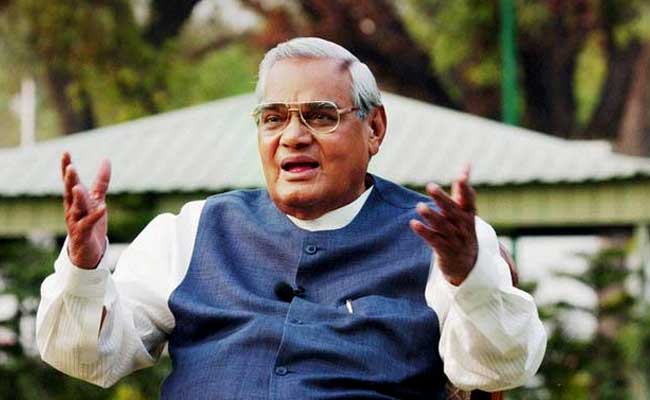
NDA called elections in early 2004, six months ahead of schedule. Its campaign was based around the slogan of “India Shining” which attempted to depict NDA government as responsible for a rapid economic transformation of the country. However, NDA suffered a defeat. It won only 186 seats in the Lok Sabha, compared to 222 by United Progressive Alliance (UPA) led by Congress.
Dr Manmohan Singh succeeded Vajpayee as the Prime Minister. Some political commentators have stated that the NDA’s failure to reach out to the rural masses was the reason for its defeat while others have pointed to its “divisive” policy agenda as the reason.
The alliance returned to power in the 2014 general elections under the leadership of Narendra Modi, who was sworn in as Prime Minister of India on 26th May 2014.
Pokhran
Pokhran is a city located in the Jaisalmer district between Jaisalmer and Bikaner,in the Indian state of Rajasthan. It is a remote location in the Thar desert where India tested its two nuclear devices in 1974 and 1998.
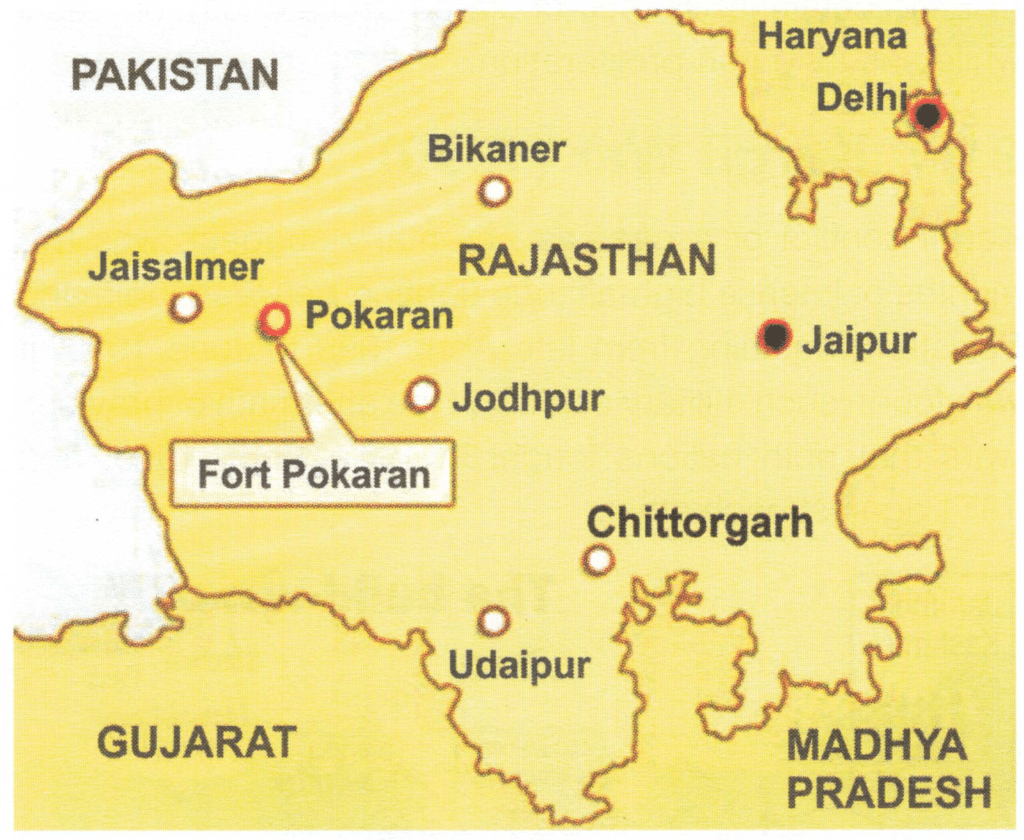
Pokhran-ll
In 1998, within days of coming to power NDA government approved the conduct of India’s second round of nuclear tests. India conducted five nuclear tests between 11th and 13th May, 1998, in an operation code named ‘Operation Shakti’ and declared herself a nuclear state, which was a departure from its internationally avowed stance of universal nuclear disarmament.
The tests attracted worldwide criticism. Sanctions were imposed by US and aid was suspended by countries like Japan, Norway, Canada and Netherlands. But France, Germany and Russia continued their normal relations. Within a fortnight of India’s tests, Pakistan conducted nuclear tests, too.
Sanctions imposed by United States on India were gradually revoked in wake of new global dynamics, post 9/11 (11 Sep, 2001) attacks at World Trade Centre in New York. An agreement called 123 agreement was moved in this direction .In 2005, after extensive negotiations, US agreed to tinker with domestic laws to enable full civilian nuclear cooperation with India.
India, in turn, agreed to separate its civil and military nuclear programs and place its civil nuclear facilities under the watch of ‘International Atomic Energy Agency (IAEA), continue its self-declared moratorium on tests while ensuring non-proliferation.
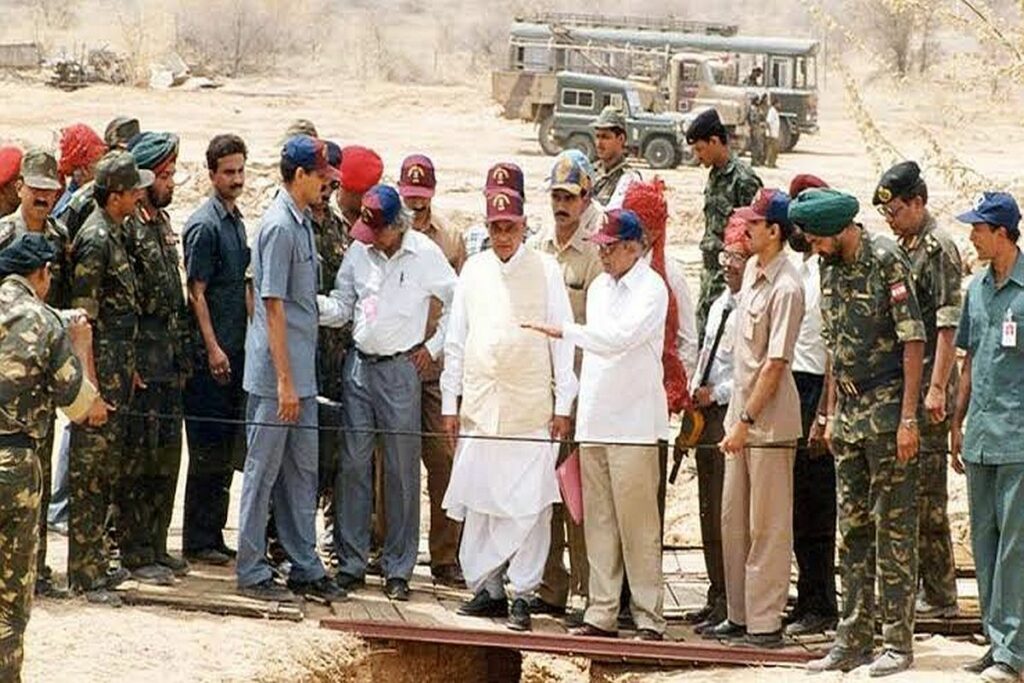
Kargil War (1999)
Kargil conflict or a near-war, as many suggest, was two months of intense high-altitude fighting between India and Pakistan beginning from late April 1999 to June 1999. It was fourth such military conflict in the aftermath of previous wars that both nations fought in 1947-1948, 1965, and 1971 against each other.
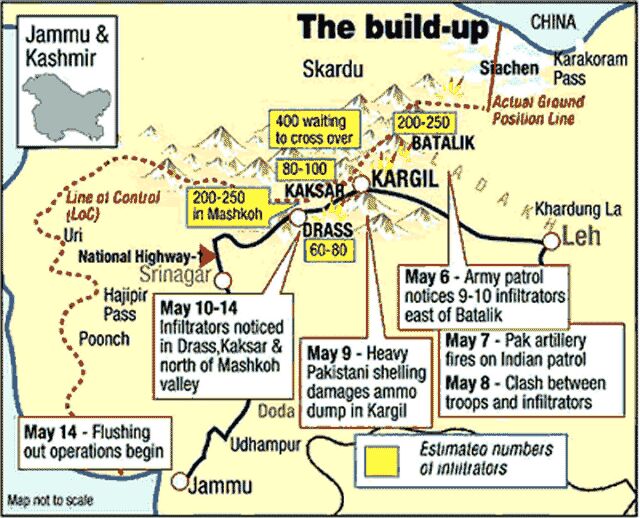
Background
Kargil is a strategically important location ever since 1947- 48. The high-altitude Zojila pass, is the only strategic passage that links Srinagar with the northern areas and Leh on Indian side of the Line Of Control (LOC), and with it, the surrounding towns of Kargil, Dras, and Skardu form the cornerstone of this region. Any intrusion through Skardu and Kargil could break the only line of communication between Srinagar and Leh and easily lead into Leh, making it one of the most vulnerable regions akin to the Kashmir valley which was threatened from north and east.
There had existed a sort of “gentleman’s agreement” between India and Pakistan that the armies of either side shall not occupy military posts from 5 September to 15th April of next year, owing to intense logistical and weather hazards associated with deploying troops, during such conditions. The ceasefire agreements and 1949 Karachi Agreement also seconded this unwritten agreement .
This had been the case since 1977, but, in the winter of 1998-1999, this agreement was cast aside by the Pakistani army in hopes of trying to gain the upper hand in Kashmir and expand its secret Kargil campaign. This plunged the Indian subcontinent into a brief and limited war while raising the spectre of nuclear war.
Course of War
In the end of April 1999, Pakistan’s intruding force had occupied about 130 posts in the Dras, Mushkoh, Kaksar, Batalik, and Chorbat-la sectors of northern Kashmir, covering an approximate area of 62 miles (100 kilometers) across the LOC, and running 4-6 miles (7 to 10 kilometers) deep into the territory held by India.
Indian army first learned about the intrusions in late April 199. What seemed like Kashmiri militant movements initially, was rebuffed by Pakistan’s well-trained and well armed Northern Light Infantry soldiers later.
In fact, Indian troops experienced weeks of enemy fire, without even seeing who was shooting at them, for the infiltrators were well hidden high atop the 13,000-18,000 feet-high (4,000-5,500-meters) mountain peaks.
Because of poor intelligence, improper acclimatization of troops, shortage of high-altitude equipment , and coordination difficulties, Indian troops suffered their heaviest casualties during this initial, frenetic phase of military engagement.
The Indian armed forces launched a major counteroffensive, code-named “Operation Vijay” (Victory), during the third week of May 1999. On 26th May, 1999 the Indian Air Force commenced air strikes in support of ground troops, vertically escalating the conflict.
The opening of Zojila in early May 1999, facilitated India’s induction of troops, supporting units, and logistics necessary for an effective counter offensive. Indian troops, simultaneously, started mobilizing in other parts of the country , deploying forces along the India-Pakistan international border and elsewhere along the LOC.
As the Indian military reclaimed more territory, Pakistani PM Nawaz Sharif found himself under mounting international pressure to pull back, resulting Washington Declaration with U.S. President Bill Clinton, for Pakistani troops to vacate the captured territory.
On 11th July, 1999 the Director Generals Military Operations (DGMOs) of Indian and Pakistani armies met at Wagah check post, where the Pakistani DGMO consented to commence withdrawal by 11th July, 1999 and complete it by 16th July, 1999 a date that, later, was extended until 18th July, 1999.
On 26th July 1999, the Indian DGMO declared at a press conference that all Pakistani intrusions had been vacated in and around the Kargil heights; thereby, marking an official end to the conflict.
Combat in Tandem
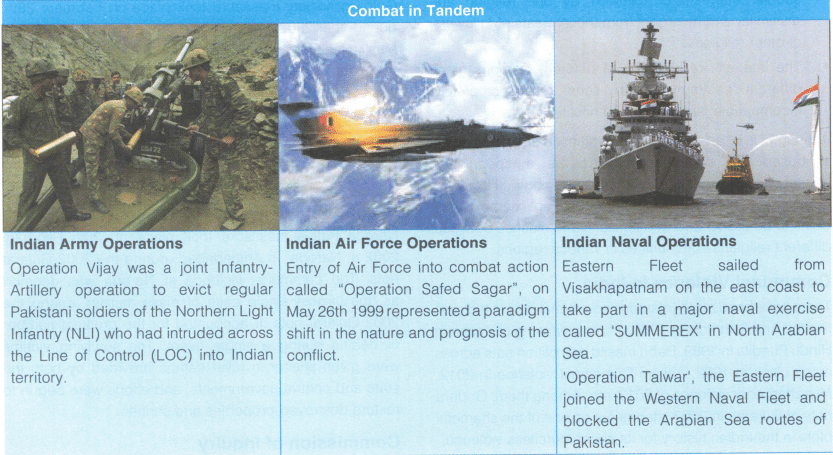
Significance of War
Deep Rooted Historical Reasons
Kargil intrusion is deeply rooted in India’s long-standing dispute with Pakistan over the political status of Jammu and Kashmir.
A successful Kargil intrusion would have shown that Pakistani soldiers were willing to endure incredible hardships to support the Kashmiri struggle. It could have given a timely boost to a weakening insurgency inside Kashmir. And, finally, had the plan succeeded, it could have forced India back to the negotiating table and given Islamabad greater leverage to resolve the Kashmir dispute on favorable terms once and for all.
Siachen Scars
India’s military seizure of Siachen glacier in northernmost Kashmir, in 1984, following the loss of hundreds of square miles of territory, around the Siachen glacier was a deep scar for Pakistan army.
Nuclear Angle
Kargil conflict caused an especially high degree of alarm worldwide because it was the first major military engagement between two countries armed with nuclear weapons, since the Sino-Soviet border clashes of 1969.
Prior to Kargil infiltration, Indian and Pakistani elites viewed their nuclear capabilities as largely political, rather than military tools, and assumed that they would stabilize their long-standing competition and would deter war. It is believed that possession of nuclear weapons and coming out of nuclear tests, in the previous year 1998, may have emboldened Pakistan to launch Kargil operation, and this significantly heightened the alarm with which India, United States, and other countries viewed Pakistan’s intrusion.
Lessons Learnt
The Kargil War is, also, significant in the sense that lessons learnt for India were failure in intelligence, operational preparedness, surprise and deception, air support, innovative use of artillery, utilization of resources within the battle, and junior leadership.
Conclusion
Kargil was a military, political and diplomatic victory for India which observes the Kargil Vijay Diwas on July 26th every year to commemorate India’s victory in the 1999 Kargil war against Pakistan. It was on this day that the Indian Army had taken control of posts across the Himalayas in the Ladakh region of Jammu and Kashmir, after fighting for about two months.
Communalism
It is, basically, an ideology which consists of three elements:
- A belief that people who follow the same religion have common secular interests i.e. they have same political, economic and social interests which results in sociopolitical commonalities.
- In a multi-religious society like India, the common secular interests of followed by one religion are dissimilar and divergent from the interests of followers of other religions.
- The interests of followers of different religions or of different ‘communities’ are seen to be completely incompatible, antagonist and hostile.
Although, it is an ideology on which communal politics is based but communal violence is a speculative consequence of this communal ideology. However, communalism in the Indian subcontinent context has come to be associated with tensions and clashes between different religious communities in various regions.
Communal Violence in India
There have been many infamous communal riots in the past like the Anti-Sikh riots of 1984, ethnic cleansing of Kashmiri Hindu Pundits in 1989, Babri masjid demolition riots across many cities in 1992, Assam Communal violence in 2012, Muzaffarnagar violence of 2013, etc. Among them, Godhra riots of Gujarat, in 2002, stands out as one of the shameful blots in the Indian history for its sheer merciless violence.
Gujarat Riots (2002)
Sabarmati Express returning from Ayodhya to Ahmedabad was stopped near the Godhra railway station on 27th February, 2002. Several of the passengers were Hindu pilgrims, returning from Ayodhya after a religious ceremony at the site of the demolished Babri Masjid. Following an argument between the passengers and locals of Godhra, the situation got inflamed and soon, four coaches of the train were set on fire, trapping many people inside.
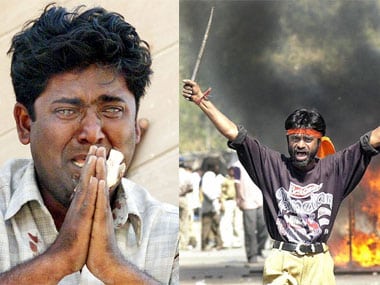
The burning of the train caused deaths of 59 people out of which 58 were Hindu pilgrims returning from Ayodhya. This instigated violence. Blaming Muslims for the blaze, furious Hindu mobs rampaged through Muslim neighborhoods in several cities of Gujarat seeking revenge during three days of bloodshed.
According to official data, 790 Muslims and 254 Hindus were killed, while 223 people went missing and 2,500 others were injured. The data by rights group say the numbers were much higher.
Gulbarg Society Massacre
Gulbarg society massacre took place on February 28th, during the 2002 Gujarat riots. Gulbarg society was a Muslim neighbourhood complex in Chamanpura area of Ahmedabad. A day after the train fire, rioters packed in trucks demolished the boundary wall of the complex and set its houses ablaze. They dragged people out and burnt them alive. It was one of the two biggest massacres during the riots – the other one was in Naroda Patiya suburb, where more than 90 died.
Naroda Patiya Massacre
Naroda Patiya massacre took place on 28th February 2002 at Naroda, in Ahmedabad, during the 2002 Gujarat riots. The communal violence at Naroda was deemed as ‘the largest single case of mass murder’ during the 2002 Gujarat riots. It accounted for the greatest number of deaths during a single event. The surviving victims were given shelter in relief camps provided by both the state and central governments, and efforts were begun to restore destroyed properties and shrines.
Commission of Inquiry
The state government formed a ‘Gujarat state commission of inquiry’ for citizens to have a forum in which to make recommendations and suggest reforms. Mainstream media criticized the Gujarat government’s handling of the riots. It was remarked that a number of reports were exaggerated. It included ‘inflammatory headlines, stories and pictures’ which were published, resulting in anti-Muslim prejudice amongs the Hindu readership.
The Nanavati-Mehta commission was set up by Gujarat government in 2002 to enquire into Gujarat violence. Further, the report submitted in Justice Nanavati Commission had mentioned that:
- 59 people, mostly kar sewaks were burnt alive on Sabarmati Express near Godhra on February 27th, 2002.
- 1,169 victims, mostly Muslims, died in the communal riots that followed the burning of the train.
Supreme Court Monitored Inquiry
Later , a Special Investigation Team (SIT) was appointed by Supreme Court of India to further look into ‘Gujarat riots’. In April 2014, Supreme Court expressed satisfaction over the SIT’s investigations in nine cases related to the violence, and rejected as ‘baseless’ a plea contesting the SIT report.
